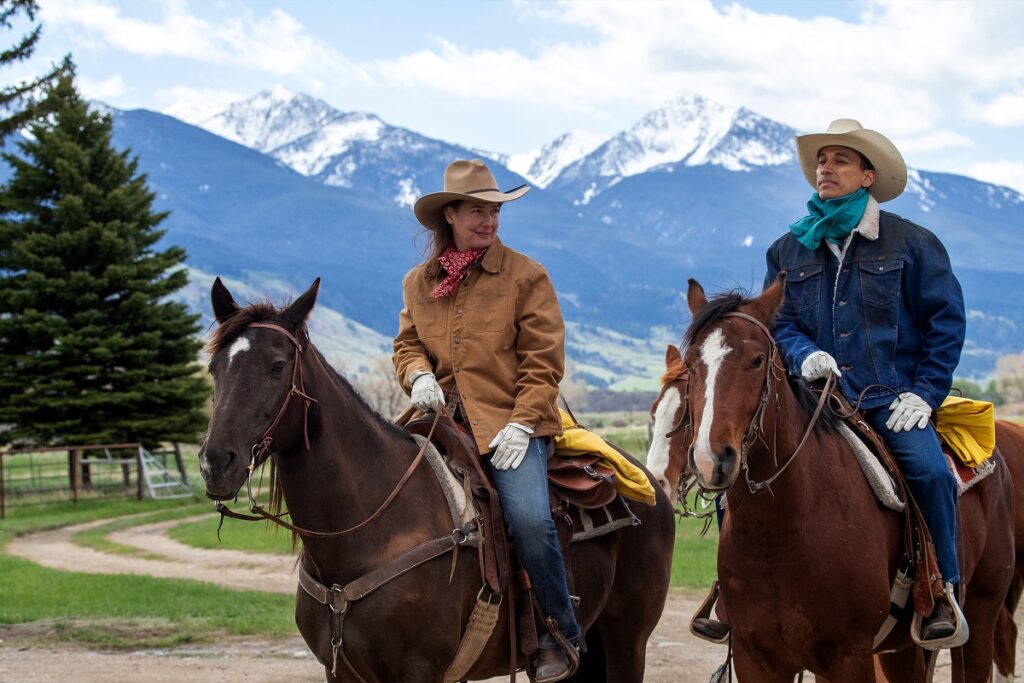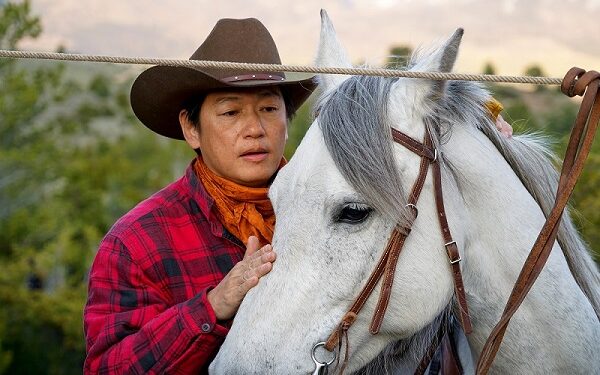Australian filmmaker Tom Goodall has been making tsunamis in Hollywood, bringing his movie making talents to both studio and independent films. From Disney’s “Lady and the Tramp” and “Christopher Robin” to his work on the phenomenal independent movie “Overpower”, we caught up with Tom to talk next steps for the award-winning film “Tokyo Cowboy” which has just wrapped in movie theatres and is now headed to digital platforms.

Welcome Tom, can you give our readers the broad strokes of the film “Tokyo Cowboy” and your role in the making of it?
Of course! “Tokyo Cowboy” is a heartwarming cross-cultural story about a Japanese businessman that goes on an unwitting journey of self-discovery when he takes a company trip from Tokyo to a Montana cattle ranch.
Our story follows Hideki Sakai, a Japanese salaryman, a no-nonsense suit-and-tie business executive who lives in the hustle and bustle of central Tokyo. In an effort to impress his superiors at the food multinational he works for, Hideki boldly volunteers to visit one of the company’s troubled cattle ranches in the US to turn it around and show off his capabilities. From the moment he steps off the plane, the adjustment from the hectic world of Tokyo to the wide expanse of Montana’s big sky country is more shocking than he expected. Hideki doesn’t speak the language, understand the culture, command any authority, and the solutions he dreamed up in the Tokyo skyscraper boardroom don’t work quite as well on the ground. But as he gets to know the ranchers and the Montana way of life, Hideki starts searching for a new way forward for the troubled ranch, and for himself.
I loved being a part of this project. On an independent film like this, everyone wears multiple hats. The lead producer asked me to come aboard the project as part of his team, way back when the project was just an idea in the director’s mind. I’d worked with this producer on several big budget studio movies by this point, so this low-budget feature was a new experience for all of us and it was all hands on deck from the start.
When a specialized issue comes up, there’s no relevant department to send it to – it just falls to you as part of the filmmaking team to find a solution. Among all the expected duties of developing the script with the writers or liaising with investors about the project, I also found myself in very unique situations. We have this one tiny gag in the movie where a Japanese character desperately wants a particular brand of fast food from America, and so I end up connecting with this company and going higher and higher up the corporate ladder to get their permission for this one silly gag. They were skeptical at first, obviously unsure how we were going to portray their product, and so I spent a surprising amount of energy working with this corporate headquarters to convince them that giving us permission was a safe idea. When you think of movie making, yes, a lot of it is lights and cameras and actors, but filmmaking is also about every single detail around those obvious elements.
You don’t get into this business necessarily to be on the phone to a burger chain negotiating how many individual fries can be shown on screen but, you know what, that is filmmaking. Deciding an effect that you want the audience to feel, planning how to achieve it, and having the know-how to pull those factors together. The more seamless a movie plays on screen, the harder the filmmakers worked to make their effort invisible and let little moments that build the larger story flow by effortlessly.
One part of the role I loved was working with our Japanese counterparts, who helped us arrange the Tokyo section of our shoot. Taking a small indie movie shoot to a foreign country where you don’t speak the language can be very daunting. Anyone will tell you that making movies is hard enough when everyone speaks the same language. In this case though, I was constantly liaising with our Japanese team to make sure they had everything they needed and were heading in the right direction, and they made everything run flawlessly. My sister lives in Japan and speaks fluent Japanese, so I was able to lean on her for some additional translation help from time to time. I’ve been brushing up on Japanese, but I’m not nearly at the level I need to be in order to communicate crucial logistic details and important creative nuance. I’m more at the “Hello what time is it” level.
Now that the US theatrical release of the movie has wrapped, we are moving into the next phase of the film’s life cycle.
Releasing an independent film into US cinemas is quite the mission, especially with so many studio films scheduling movies all at once. How did the theatrical release for “Tokyo Cowboy” figure?
We were thrilled with our theatrical release. The goal with any release is always to try and punch above your weight, and we had some knockouts.
In film distribution, the big metric of a movie’s commercial viability is its “per-screen average” – this is how much box office revenue a movie makes per screen it’s shown on. This is an essential factor for cinema owners deciding what films to program. Imagine you’re a cinema owner and you’ve got one of your screens open, so you want to play a film that will sell the most seats in the room. You can just play the latest studio blockbuster one more time but what if people aren’t turning out for it? If you hear about an indie film that’s selling out every cinema it’s played in, that’s the movie you want to show.
Luckily for us, when our movie opened on Labor Day weekend, the per-screen average for “Tokyo Cowboy” was the highest – yes, the HIGHEST – of all films that weekend. And Labor Day weekend is a very competitive window! Audiences were excited for our film from the start, filling cinemas in big cities and small towns. This meant that more cinemas wanted to pick the film up or keep it playing. We only planned for a limited 3-week run, but it ended up going for 3 months!
Aside from the United States, did you exhibit the film elsewhere?
Yes, we also released the film in Japan, the other half of our cross-cultural story. We knew this was a risky move as Japanese moviegoing audiences are usually very skeptical of western-produced films about Japan. Even the most well intended and thoroughly researched films often fail to capture the essence of Japanese culture. In this case though, our theatrical run in Japan was an incredible success. Just like in the US, popular demand kept the film playing for weeks and weeks longer than we anticipated.
Everyone involved was dedicated to getting the cultural nuances right, of both Japanese and rural American culture. The film is about these cultural divides after all, so we had to make it authentic. We had plenty of Americans in our core creative team, such as director Marc Marriott and most of our producers, but we also had important Japanese voices. The screenplay was written by Ayako Fujitani and Dave Boyle; Ayako is a Japanese native who now lives in the US, and Dave Boyle is a Japanese-speaking American who lives between both countries. With these two crafting the cultural nuances, plus the entire team’s dedication to getting our depictions right, it’s been very rewarding to see Japanese audiences have such a positive response.
How can people see the movie?
Well, after a theatrical run like that, we’re eager to get the film onto streaming platforms so anyone who missed it can see it for themselves. We’re still ironing out the details, but it’ll be beaming to screens near you by March next year. We’re also working on the DVD/Blu-ray release with some great special features. The Behind The Scenes featurette showing the incredible Montana and Tokyo locations is a treat, but we’re also going to have a deep dive with the film’s star Arata Iura. If this movie spoke to you, Arata’s insights will take you even deeper into the film’s positive message.
Watch the official trailer here:
In today’s Hollywood, there is a significant push for greater inclusivity and representation. How do you see your work contributing to this movement, and what changes do you still hope to see in the industry?
Not only is it an obvious moral imperative to remove all arbitrary barriers and make sure everyone feels welcome, but it makes our stories better. It’s easier to make content now than it’s ever been, so more is being made, and all of us as audiences always want the best possible experience. If the industry is going to meet that demand, we need all the help we can get. We don’t need to force it, just open up the doors. There are great stories in every corner of this world, we’d be foolish as well as bigoted if we turn anyone away. That’s why a movie like “Tokyo Cowboy” is yet another step in a positive direction. It opens people up to other cultures, other ideas, but also shows the universality of the human experience. The more we showcase the incredible creativity of people different from ourselves, the more we learn about each other, and the more we realize that we recognize each other.
Thank you so much. What is the best way for people wanting to follow your journey?
Thank you! Folks can follow me on Instagram, or find my work at IMDb or tomgoodall.com


